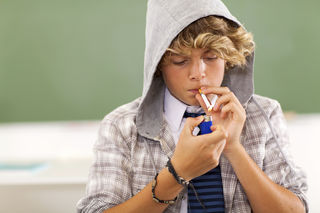Adolescence
Why Are Teen Brains Designed for Risk-taking?
Here are four ways parents can reduce the danger
Posted June 9, 2015 Reviewed by Lybi Ma
By Nina S. Mounts, Ph.D., guest contributor
Adolescents and young adults take more risks than any other age group (Steinberg, 2008). This risk-taking includes dangerous driving (e.g. texting), drug use, binge drinking, and risky sexual behavior. Despite educational efforts to provide teens with information about risky behavior, many adolescents continue to engage in risky behavior (Kann, et al., 2014).

How do we explain the persistence of teens’ risky behavior, despite the large amount of money being spent on prevention programs? What can we do to reduce the danger?
A growing body of brain research is providing answers to these questions. People often believe that teens engage in risky behavior because they are not very good at evaluating risk. But early research in this area demonstrated that adolescents are just as good as adults at evaluating risk across a broad range of risky behavior (Beyth-Marom, Austin, Fischoff, Pamlgren, & Jacobs-Quadrel, 1993). Teens know that the behaviors are risky, but they still engage in them. Why?
Research on peer relationships and brain development during the adolescence period may provide an answer.
In recent years, there has been an increase in the availability of magnetic resonance imaging (MRI) and functional magnetic resonance imaging (fMRI). Using these tools, researchers have found several changes in the brain during puberty (Blakemore, Burnett, & Dahl, 2010; see Blakemore, 2012 for review) that are important in explaining risky behavior.
First, during the adolescence period, there is an increased interest in peer relationships (Larson & Richards, 1991), and susceptibility to peer influence increases during the early teen years and peaks at about age 14 (Berndt, 1979). Consistent with these readily observable changes in peer relationships, brain imaging studies have shown that several areas of the brain make adolescents more sensitive to the rewards of peer relationships than adults (Albert, Chein, & Steinberg, 2013). This motivates teens to focus on their peers in decision-making situations that involve risky behavior.
Second, adolescents are more distressed than adults when excluded by peers. A brain region known as the right ventrolateral prefrontal cortex (PFC) might be important in helping people cope with negative evaluations from peers by reducing distress. Research shows that this brain region is used more heavily by adults when being socially excluded than by adolescents (Sebestian, et al., 2011). When teens do use this area of the brain during peer exclusion, they report lower levels of distress (Masten, et al., 2009).
During the adolescent years, however, this brain region is still developing (Blakemore & Mills, 2014), so adolescents may not be as effective at controlling distress during peer social exclusion. This likely contributes to engaging in risky behaviors to prevent being excluded by their peers.
Third, another area of the brain, the lateral prefrontal cortex (PFC), is responsible for mature self-regulation and develops gradually over the adolescence period (Albert, et al., 2013). In one study, early adolescents, late adolescents, and adults behaved similarly on a computerized driving task when they were by themselves (Gardner & Steinberg, 2005). However, when they were paired with two same-aged friends, clear differences emerged. Early adolescents were more likely to engage in risky driving when friends were present. Late adolescents were somewhat more risky in their driving when they were with friends. The presence of friends had no impact on adults’ driving.
Using the computerized driving task in conjunction with an fMRI, researchers found that, in contrast to adults, adolescents were more likely to engage in risky driving when they knew that their friends were observing them than when they were alone (Chein, Albert, O’Brien, Uckert, & Steinberg (2011). The area of the brain that was used by the adults, the PFC, helps with decision-making and self-regulation in tasks such as driving. In contrast, adolescents used areas of the brain that are more closely associated with rewards when completing the driving task.
We have changes in the brain during early adolescence that make teens more focused on the rewards of peers and being included in peer activities. This increased focus on peers occurs during a time when the PFC is not yet ready to assist in mature self-regulation. These factors provide a “perfect storm” of opportunities for risky behavior.
If talking about the dangers of risky behaviors isn’t as effective in preventing them as parents would like, what can parents do?
There are several approaches that parents can use to more effectively manage teens’ peer relationships (Mounts, 2004; 2008; Steinberg, 2010).
1. For younger adolescents, parent(s) might design the environment to provide safe activities that focus on young teens’ need for sensation-seeking (Mounts, 2004; 2008). For example, adult-supervised outdoor activities with peers, such as rock climbing and zip-lining, can provide a great context for providing the excitement and social relationships needed for young teens.
2. Supervising teens’ interactions with peers and providing rules for peer interactions can limit opportunities for risky behavior (Mounts, 2002; 2004; 2008; Steinberg, 2010).
3. Parents also should know and enforce graduated driving laws. Very often these laws limit the number of peers that are allowed in a vehicle when teens are driving.
4. For older adolescents, parents can consult with teens about peers. Consulting can build on teens’ growing ability to self-regulate and encourage them to identify and develop strategies for navigating peer situations where the risky activity is likely to occur (Mounts, 2004; 2008).
Nina Mounts is a professor of psychology at Northern Illinois University and director of the Northern Illinois University Collaborative on Early Adolescence. Her research focuses on parenting and peer relationships during adolescence.
References
Berndt, T.J. Developmental changes in conformity to peers and parents. Developmental Psychology, 15, 608-616.
Beyth-Marom, R., Austin, L., Fischoff, B., Palmgren, C., & Jacobs-Quadrel, M. (1993). Perceived consequences of risky behavior: Adults and adolescents. Developmental Psychology, 29, 549-563.
Blakemore, S. (2012). Imaging brain development: The adolescent brain. NeuroImage, 61, 397-406.
Blakemore, S., Burnett, S., & Dahl, R.E. (2010). The role of puberty in the developing adolescent brain. Human Brain Mapping, 31, 926-933.
Blakemore, S., & Mills., K.L. (2014). Is adolescence a sensitive period for sociocultural processing? Annual review of Psychology, 65, 187-207.
Chein, J., Albert, D., O’Brien, L., Uckert, K., & Steinberg, L. (2011). Peers increase adolescent risk taking by enhancing activity in the brain’s reward circuitry. Developmental Science, 14, F1-F10.
Dustin, A., Chein, J., & Steinberg, L. (2013). The teenage brain: Peer influence on adolescent decision-making. Current Directions in Psychological Science, 22, 114-120.
Gardner, M. & Steinberg, L. (2006). Peer influence on risk taking, risk preference, and risky decision making in adolescence and adulthood: An experimental study. Developmental Psychology, 41, 625-635.
Kann, L., Kinchen, S., Shanklin, S.L., Flint, K.H., Hawkins, J., Harris, W.A., Lowry, R., O’Malley Olson, E., McManus, T., Chyen, D., Whittle, L., Tayloy, E., Demisie, Z., Brener, N., Thornton. J., Moore, J., & Zaza, S. (2014). Youth risk behavior surveillance – United States 2013. Center for Disease Control and Prevention Morbidity and Mortality Weekly Report, 63, 1-168.
Larson, R., & Richards, M. Daily companionship in late childhood and early adolescence: Changing developmental context. Child Development, 62, 284-300.
Masten, C.L., Eisenberger, N.I., Borofsky, L.A., Pfeifer, J.H., McNealy, K., Mazziotta, J.C., & Dapretto, M. (2009). Neural correlate of social exclusion during adolescence: Understanding the distress of peer rejection. Social Cognitive Affective Neuroscience, 4, 143-157.
Mounts, N. S. (2008). Linkages between parenting and peer relationships: A model for parental management of adolescents’ peer relationships. In M. Kerr, H. Stattin, & R. Engels, (Eds.), What can parents do: New insights into the role of parents in adolescent problem behaviour (pp. 163-189). West Sussex, UK: Wiley.
Mounts, N.S. (2004). Adolescents’ perceptions of parental management of peer relationships in an ethnically diverse sample. Journal of Adolescent Research, 19, 446-467.
Mounts, N. S. (2002). Parental management of adolescent peer relationships in context: The role of parenting style. Journal of Family Psychology,16, 58-69.
Sebestian, C.L., Viding, E. Williams, K.D., & Blakmore, S. (2010). Social brain development and the effective consequences of ostracism in adolescence. Brain Cognition, 72, 134-145.
Sebestian, C., Tan, G.C., Roiser, J.P., Viding, E., Dumontheil, I., Blakemore, S. (2011). Developmental influences on the neural bases of responses to social rejection: Implications of social neuroscience for education. NeuroImage, 57, 686-694.
Steinberg, L. (2010). A dual systems model of adolescent risk-taking. Developmental Psychobiology, 52, 216-224.




